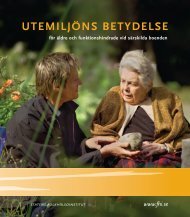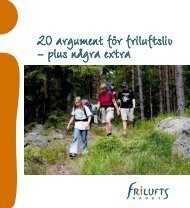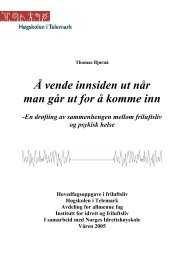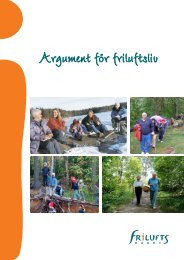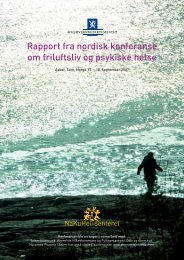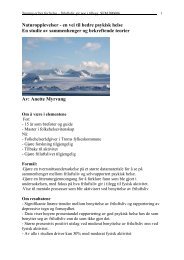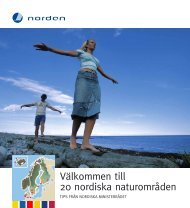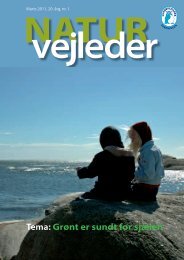Green Care: A Conceptual Framework - Frisk i naturen
Green Care: A Conceptual Framework - Frisk i naturen
Green Care: A Conceptual Framework - Frisk i naturen
You also want an ePaper? Increase the reach of your titles
YUMPU automatically turns print PDFs into web optimized ePapers that Google loves.
6.16 Group analytic theory<br />
Group Analytic Theory is a form of group psychotherapy (also known<br />
as group analytic psychotherapy) that has since grown into the major<br />
international school of group-based psychoanalysis. Characteristically, it<br />
uses the concepts of the unconscious and psyche defences in a similar way<br />
to Freud – but stresses the indivisible social nature of the analysis:<br />
“Each individual – itself an artificial, though plausible,<br />
abstraction – is centrally and basically determined, inevitably,<br />
by the world in which he lives, by the community, the group, of<br />
which he forms a part. The old juxtaposition of an inside and<br />
outside world, constitution and environment, individual and<br />
society, phantasy and reality, body and mind and so on, are<br />
untenable. They can at no stage be separated from each other,<br />
except by artificial isolation.” (Foulkes, 1964, p. 10)<br />
This starkly states the implausibility of individualism and importance<br />
of relationships. Foulkes, in a different language but similar spirit to<br />
Jung, describes a phenomenon of group relations in a similar depth to<br />
Jung’s collective unconscious. This is what Foulkes calls the ‘foundation<br />
matrix’ of the group. In it, the network of relationships of group members<br />
is unconsciously (and partly consciously) experienced as a healing and<br />
reparative force:<br />
“The matrix is the hypothetical web of communication and<br />
relationship in a given group. It is the common shared ground<br />
which ultimately determines the meaning and significance<br />
of all events and upon which all communications and<br />
interpretation, verbal and non-verbal, rest.” (Foulkes, 1964,<br />
p. 292)<br />
Once established as a trusting and enabling environment, a wellfunctioning<br />
group can be experienced as a healing, holding and sometimes<br />
transcendental space. A group analytic description of this relates it to the<br />
parallel of infant development and the pre-verbal experience of belonging<br />
and safety (attachment and containment). These experiences necessarily<br />
precede more rational and cognitive functioning, and are not directly<br />
related to the words spoken in groups (Haigh, 1999). They are more<br />
related to the ‘natural rhythms’ of activity and aspects of regularity and<br />
95







